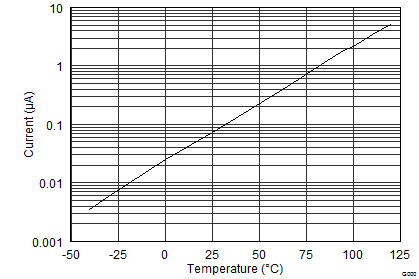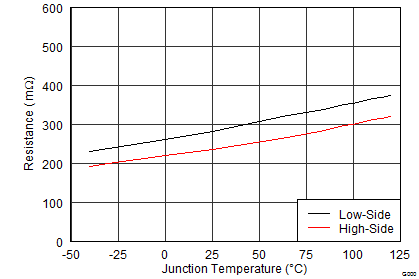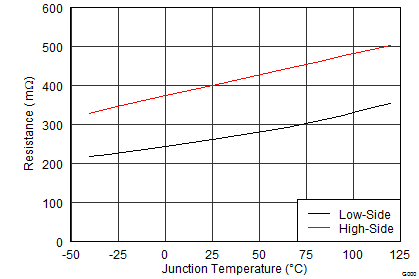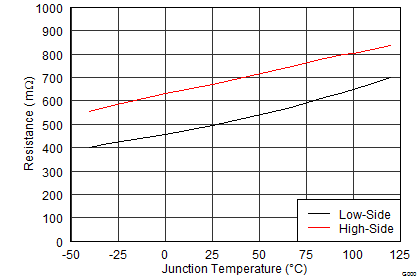ZHCSDG2 March 2015 TPS65632
PRODUCTION DATA.
- 1 特性
- 2 应用范围
- 3 说明
- 4 简化电路原理图
- 5 修订历史记录
- 6 Pin Configuration and Functions
- 7 Specifications
-
8 Detailed Description
- 8.1 Overview
- 8.2 Functional Block Diagram
- 8.3 Feature Description
- 8.4 Device Functional Modes
- 9 Application and Implementation
- 10Power Supply Recommendations
- 11Layout
- 12器件和文档支持
- 13机械、封装和可订购信息
7 Specifications
7.1 Absolute Maximum Ratings
over operating free-air temperature range (unless otherwise noted)(1)| MIN | MAX | UNIT | ||
|---|---|---|---|---|
| Input supply voltage(2) | SWP1, OUTP1, FBS, PVIN, AVIN | –0.3 | 5 | V |
| SWP2 | –0.3 | 12 | V | |
| OUTP2 | –0.3 | 8.5 | V | |
| OUTN | –6.0 | 0.3 | V | |
| SWN | –6.5 | 4.8 | V | |
| CTRL, EN, SELP2 | –0.3 | 5.5 | V | |
| CT | –0.3 | 3.6 | V | |
| Operating virtual junction, TJ | –40 | 150 | °C | |
| Storage temperature, Tstg | –65 | 150 | °C | |
(1) Stresses beyond those listed under absolute maximum ratings may cause permanent damage to the device. These are stress ratings only, and functional operation of the device at these or any other conditions beyond those indicated under recommended operating conditions is not implied. Exposure to absolute-maximum-rated conditions for extended periods my affect device reliability.
(2) With respect to GND pin.
7.2 ESD Ratings
| VALUE | UNIT | |||
|---|---|---|---|---|
| V(ESD) | Electrostatic discharge | Human body model (HBM), per ANSI/ESDA/JEDEC JS-001, all pins(1) | ±2000 | V |
| Charged device model (CDM), per JEDEC specification JESD22-C101, all pins(2) | ±500 | |||
(1) JEDEC document JEP155 states that 500-V HBM allows safe manufacturing with a standard ESD control process.
(2) JEDEC document JEP157 states that 250-V CDM allows safe manufacturing with a standard ESD control process.
7.3 Recommended Operating Conditions
over operating free-air temperature range (unless otherwise noted)| MIN | NOM | MAX | UNIT | ||
|---|---|---|---|---|---|
| INPUT | |||||
| VI | Input supply voltage range | 2.9 | 3.7 | 4.5 | V |
| TJ | Operating junction temperature | –40 | 85 | 125 | °C |
7.4 Thermal Information
| THERMAL METRIC(1) | RTE [WQFN] | UNIT | |
|---|---|---|---|
| 16 PINS | |||
| RθJA | Junction-to-ambient thermal resistance | 42.9 | °C/W |
| RθJC(top) | Junction-to-case (top) thermal resistance | 44 | |
| RθJB | Junction-to-board thermal resistance | 14.2 | |
| ψJT | Junction-to-top characterization parameter | 0.6 | |
| ψJB | Junction-to-board characterization parameter | 14.1 | |
| RθJC(bot) | Junction-to-case (bottom) thermal resistance | 3.3 | |
(1) For more information about traditional and new thermal metrics, see the IC Package Thermal Metrics application report, SPRA953.
7.5 Electrical Characteristics
VI = 3.7 V, CTRL = 3.7 V, EN = 3.7 V, VPOS = 4.6 V, VNEG = –4.0 V, AVDD = 7.7 V, TJ = –40°C to 85°C, typical values are at TJ = 25°C (unless otherwise noted)| PARAMETER | TEST CONDITIONS | MIN | TYP | MAX | UNIT | ||
|---|---|---|---|---|---|---|---|
| SUPPLY CURRENT AND THERMAL PROTECTION | |||||||
| VI | Input voltage range | 2.9 | 3.7 | 4.5 | V | ||
| ISD | Shutdown current | CTRL = GND, EN = GND, sum of current flowing into AVIN and PVIN | 0.25 | 5 | µA | ||
| VUVLO | Under-voltage lockout threshold | VI falling | 1.8 | 2.1 | V | ||
| VI rising | 2.1 | 2.5 | V | ||||
| BOOST CONVERTER 1 (VPOS) | |||||||
| VPOS | Positive output 1 voltage | 4.6 | V | ||||
| Positive output 1 voltage variation | 25°C ≤ TA ≤ 85°C, No load | –0.5% | 0.5% | ||||
| –30°C ≤ TA ≤ 85°C, No load | –0.8% | 0.8% | |||||
| rDS(on)1A | Switch on-resistance | I(SWP1) = 200 mA | 200 | mΩ | |||
| rDS(on)1B | Rectifier on-resistance | 350 | mΩ | ||||
| fSW1 | Switching frequency | IPOS = 200mA | 1.7 | MHz | |||
| ISW1 | Switch current limit | Inductor valley current | 0.8 | 1 | 1.4 | A | |
| VSCP1 | Short-circuit threshold in operation | VPOS falling | 3.95 | 4.10 | 4.28 | V | |
| tSCP1 | Short-circuit detection time in operation | 3 | ms | ||||
| VT | Output voltage sense threshold | V(OUTP1) – V(FBS) increasing | 200 | 300 | 550 | mV | |
| V(OUTP1) – V(FBS) decreasing | 100 | 200 | 450 | mV | |||
| R(FBS) | FBS pin pull-down resistance | 2 | 4 | 6 | MΩ | ||
| RDCHG1 | Discharge resistance | CTRL = GND, I(SWP1) = 1mA | 10 | 30 | 70 | Ω | |
| Line regulation | IPOS = 200mA | 0.01 | %/V | ||||
| Load regulation | 1 mA ≤ IPOS ≤ 300 mA | 0.007 | %/A | ||||
| INVERTING BUCK-BOOST CONVERTER (VNEG) | |||||||
| VNEG | Output voltage default | –4.0 | V | ||||
| Output voltage range | –1.4 | –5.4 | |||||
| Output voltage accuracy | 25°C ≤ TA ≤ 85°C, no load | –50 | 50 | mV | |||
| –30°C ≤ TA ≤ 85°C, no load | –60 | 60 | |||||
| rDS(on)2A | SWN MOSFET on-resistance | I(SWN) = 200 mA | 200 | mΩ | |||
| rDS(on)2B | SWN MOSFET rectifier on-resistance | 300 | mΩ | ||||
| fSW2 | SWN Switching frequency | INEG = 10 mA | 1.7 | MHz | |||
| ISW2 | SWN switch current limit | VI = 2.9 V | 1.5 | 2.2 | 3 | A | |
| VSCP2 | Short circuit threshold in operation | Voltage increase from nominal VNEG | 300 | 500 | 700 | mV | |
| Short circuit threshold in start up | 180 | 200 | 230 | mV | |||
| tSCP2 | Short circuit detection time in start up | 10 | ms | ||||
| Short circuit detection time in operation | 3 | ms | |||||
| RDCHG2 | Discharge resistance | CTRL = GND, I(SWN) = 1 mA | 130 | 150 | 170 | Ω | |
| Line regulation | INEG = 200 mA | 0.004 | %/V | ||||
| Load regulation | 0.1 | %/A | |||||
| BOOST CONVERTER 2 (AVDD) | |||||||
| AVDD | Output voltage | SELP2 = Low | 7.7 | V | |||
| SELP2 = High | 5.8 | ||||||
| Output voltage accuracy | 25°C ≤ TA ≤ 85°C, no load | –1% | 1% | ||||
| –30°C ≤ TA ≤ 85°C, no load | –1.3% | 1.3% | |||||
| rDS(on)3A | SWP2 switch on-resistance | I(SWP2) = 200 mA | 400 | mΩ | |||
| rDS(on)3B | SWP2 rectifier on-resistance | 650 | |||||
| fSW3 | Switching frequency | IAVDD = 0 mA | 1.7 | MHz | |||
| ILIM3 | Switch current limit | Inductor valley current | 0.25 | 0.35 | 0.45 | A | |
| RDCHG3 | Discharge resistance | EN = GND, I(SWP2) = 1 mA | 10 | 30 | 70 | Ω | |
| Line regulation | IAVDD = 30 mA | 0.02 | %/V | ||||
| Load regulation | 0.18 | %/mA | |||||
| CTRL INTERFACE (CTRL, EN, SELP2) | |||||||
| VIH | Logic input high level voltage | 1.2 | V | ||||
| VIL | Logic input low level voltage | 0.4 | V | ||||
| R | Pull-down resistance | 150 | 400 | 860 | kΩ | ||
| OTHER | |||||||
| RCT | CT pin resistance | 150 | 300 | 500 | kΩ | ||
| tINIT | Initialization time | 300 | 400 | µs | |||
| tSTORE | Data storage/accept time period | 30 | 80 | µs | |||
| tSDN | Shutdown time period | 30 | 80 | µs | |||
| TSD | Thermal shutdown temperature | Temperature rising | 145 | °C | |||
7.6 Timing Requirements
| MIN | NOM | MAX | UNIT | ||
|---|---|---|---|---|---|
| CTRL INTERFACE | |||||
| tLOW | Low-level pulse duration | 2 | 10 | 25 | µs |
| tHIGH | High-level pulse duration | 2 | 10 | 25 | µs |
| tOFF | Shutdown pulse duration (CTRL = low) | 200 | µs | ||
7.7 Typical Characteristics
TJ = 25°C, VI = 3.7 V, unless otherwise stated.


